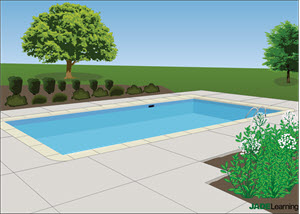Bill Annett
Senior Member
- Location
- Wheeling, WV
- Occupation
- Retired ( 2020 ) City Electrical inspector
I have a problem and need some advice. A friend of mine had an in-ground pool installed. The pool is fiberglass. The pool water is not in contact with any metal components The pool people did the bonding. They bonded everything as per the NEC but did not do the bonding of the water.
The home owner just sees a nice-looking pool with a concrete walkway around the pool. I see an installation that does not meet the NEC and could endangers the people who uses the pool which include his 2 small children.
Any suggestions of how he could bond the water would be appreciated. You cannot get to the skimmer. My idea would be to dig down into the soil, as close to the pool as possible and locate the PVC pipes that goes to the pool filter. Cut the pipe and install a section of copper pipe which would have at least 9 square inches exposed to the water. Then install a water pipe clamp listed for direct burial, run a solid copper # 8 or #6 and connect it the bonding conductor that goes to the pump. Also let me know what you think of my idea.
Any suggestions will be appreciated. Thanks
The home owner just sees a nice-looking pool with a concrete walkway around the pool. I see an installation that does not meet the NEC and could endangers the people who uses the pool which include his 2 small children.
Any suggestions of how he could bond the water would be appreciated. You cannot get to the skimmer. My idea would be to dig down into the soil, as close to the pool as possible and locate the PVC pipes that goes to the pool filter. Cut the pipe and install a section of copper pipe which would have at least 9 square inches exposed to the water. Then install a water pipe clamp listed for direct burial, run a solid copper # 8 or #6 and connect it the bonding conductor that goes to the pump. Also let me know what you think of my idea.
Any suggestions will be appreciated. Thanks



